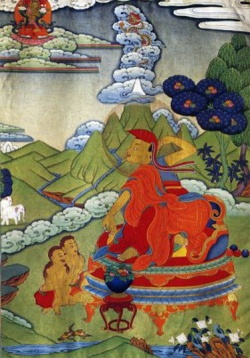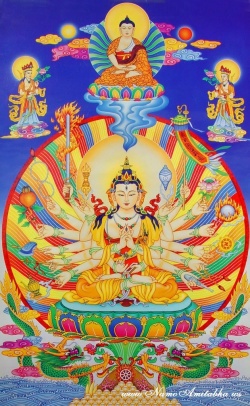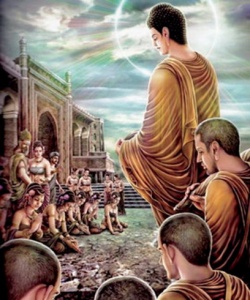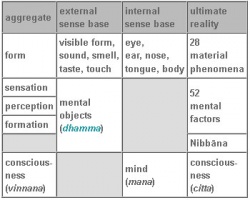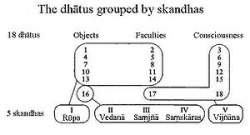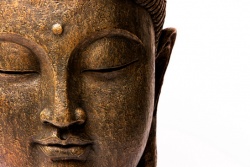Difference between revisions of "Five Skandhas"
(Created page with "The word we sometimes use in English interchangeably with "person" is "individual" that carries the idea of "not divisible." But the Sanskrit term pudgala that is used by Jain...") |
m (Text replacement - "illustrated" to "illustrated") |
||
| (27 intermediate revisions by 4 users not shown) | |||
| Line 1: | Line 1: | ||
| − | The | + | [[File:Our-Mind.jpg|thumb|250px|]]{{DisplayImages|57|738|356|901|1092}} |
| + | <poem> | ||
| + | [[Five Skandhas]] The [[five groups of elements]] ([[Dharmas]]) into which all [[existences]] are classified in [[early Buddhism]]. | ||
| − | + | The five are: | |
| − | + | [[Rupa]] ({{Wiki|matter}}), | |
| + | [[Vedana]] ([[feeling]]), | ||
| + | [[Sanjna]] ([[ideation]]); | ||
| + | [[Samskara]] (forces or drives) | ||
| + | [[Vijnana]] ([[consciousness]] or [[sensation]]). | ||
| − | + | Group, heap, [[aggregate]]; | |
| − | + | the five constituents of the [[personality]]; | |
| − | + | [[form]], | |
| + | [[feeling]], | ||
| + | [[perception]], | ||
| + | {{Wiki|impulses}}, | ||
| + | [[consciousness]]; | ||
| − | + | the five factors constituting the {{Wiki|individual}} [[person]]. | |
| − | The | + | The [[word]] we sometimes use in English interchangeably with "[[person]]" is "{{Wiki|individual}}" that carries the [[idea]] of "not divisible." But the [[Sanskrit]] term [[pudgala]] that is used by {{Wiki|Jains}} and by [[Buddhists]] which confers that same "[[person]]" meaning actually connotes a temporary [[entity]] that is prone to separation into parts and then, to assimilation. It is not one whole that is a solid, indivisible [[entity]]. Instead the [[person]] is viewed as made up of five different aspects called the 5 [[Skandhas]] or [[Five Aggregates]]. These are not [[physical]] components, but rather an agglomeration or coming together of {{Wiki|subliminal}} inclinations or {{Wiki|tendencies}}. |
| + | </poem> | ||
| + | === [[Suffering]] and the [[Skandhas]] === | ||
| − | + | "Everything is [[suffering]] [Skt. [[dukkha]]" is the [[1st 'Noble' Truth]] ([[aryasatya]]) [[Noble]]> [[arya]] which here means supreme, [[ultimate]].) | |
| − | + | [[Suffering]] = un-satisfactoriness, not OK, and much of that has to do with the [[impermanent]] [[nature]] of [[phenomena]] [things, events and states] due in part to the fact they are composed of temporary assemblages or [[skandhas]]. | |
| − | + | === [[Impermanence]] === | |
| − | |||
| − | |||
| − | |||
| − | |||
| − | + | [[Existence]] is [[suffering]] primarily because, by its very [[nature]], it is [[impermanent]]. That is, [[people]], [[animals]], things, circumstances ("[[life]]-style") and all the components that go to make them up - good [[health]] - are transitory. Often the [[word]] chosen to translate [[dukkha]] is '{{Wiki|unsatisfactoriness}}'. | |
| − | + | Though they say in {{Wiki|French}}, The more things change, the more they remain the same] that [[sameness]] is never [[permanent]] but always changing, uncertain, often risky and creating of [[stress]]. | |
| − | + | The [[doctrine]] of why and how this is appears in the [[Mahanidana Sutta]] or The [[Great Causation Sutra]]. | |
| − | |||
| − | |||
| − | |||
| − | |||
| − | |||
| − | + | The [[Buddhist]] [[view]] is that every {{Wiki|individual}} is an [[entity]] composed of five categories of [[phenomena]] or qualities that may be [[thought]] of as [[aggregates]], [[skandhas]] in [[Sanskrit]]; sometimes translated as heaps or [[accumulations]]. | |
| − | + | The [[Five Skandhas]], also called [[Formations]] are: | |
| − | + | # [[form]] ([[rupa]]) | |
| + | # [[apperception]] or {{Wiki|sensibility}} | ||
| + | # [[perception]] | ||
| + | # [[Wikipedia:Volition (psychology)|volition]], will | ||
| + | # [[consciousness]] | ||
| − | + | 1. [[Form]] is composed of {{Wiki|matter}} made up of [[four elements]]: [[earth]], [[water]], [[fire]], [[wind]]. | |
| − | + | [[File:Ph rain.jpg|thumb|250px|]] | |
| − | + | 2. {{Wiki|Apperception}} or {{Wiki|sensibility}} is derived from the [[sense]] {{Wiki|organs}}: | |
| − | + | # [[eye]] enables [[sight]] | |
| + | # {{Wiki|ear}} enables [[sound]] | ||
| + | # {{Wiki|nose}} enables {{Wiki|odour}} | ||
| + | # {{Wiki|tongue}} enables {{Wiki|taste}} | ||
| + | # "[[body]]" enables {{Wiki|touch}} | ||
| + | # [[mind]] enables the [[experiences]] of the [[five organs]] above, but also of its own [[objects]] called, like the [[word]] for the Teachings, [[dharma]]s ('facts'). | ||
| − | + | This set of pairs, ie. {{Wiki|organ}} + [[function]], is known as the Twelve (12) Bases of [[Consciousness]]. | |
| − | Outside of Buddhist didactic contexts, "skandha" can mean mass, heap, pile, bundle or tree trunk. | + | 3. [[Perception]] is a product of the six externals above: [[sight]], [[sound]], etc. It is the individual's processing of the 12 bases to '[[feel]]' the environment. (This [[skandha]] is sometimes referred to as '[[feeling]]' though that [[word]] could be used in an vague way for any of the [[skandhas]] from 2 through 4.) |
| + | |||
| + | 4. [[Wikipedia:Volition (psychology)|Volition]] ([[samskara]]) is the {{Wiki|reaction}} of the will to the [[objects]] and may produce [[aversion]], [[attraction]], etc. In other words, the [[feeling]] as basis for [[emotion]]. | ||
| + | |||
| + | 5. [[Consciousness]] ([[vijnana]]) [[grasps]] the qualities of the six [[objects]]. It creates a third member of the sets in 2 above. These are designated [[Visual]] [[consciousness]], {{Wiki|Auditory}} [[consciousness]], and so on, ending with [[Mental]] [[consciousness]]. The eighteen now, are called the Eighteen (18) [[Elements]] ([[dhatu]]). | ||
| + | |||
| + | These [[five aggregates]] or [[formations]], the [[skandas]], are not [[ultimate]] and [[eternal]] in [[nature]] but are [[conditioned]]. They arise from [[causes]] and circumstances. Like all [[phenomena]], they come and go; endure and change and disappear. | ||
| + | |||
| + | Since we are composed of these, we are [[impermanent]]. There is no part of us that is [[eternal]]. We cannot [[logically]] say, "That is mine; I am that; that is my [[Self]]" | ||
| + | |||
| + | In [[Buddhist]] {{Wiki|phenomenology}} and {{Wiki|soteriology}}, the [[skandhas]] ([[Sanskrit]]) or [[khandhas]] ([[Pāli]], [[aggregates]] in English) are any of five types of [[phenomena]] that serve as [[objects]] of [[clinging]] and bases for a [[sense]] of [[self]]. The [[Buddha]] teaches that [[nothing]] among them is really "I" or "mine". | ||
| + | |||
| + | [[File:Qja0yo.jpg|thumb|250px|]] | ||
| + | |||
| + | In the [[Theravada]] [[tradition]], [[suffering]] arises when one identifies with or otherwise clings to an [[aggregate]]; hence, [[suffering]] is [[extinguished]] by relinquishing [[attachments]] to [[aggregates]]. The [[Mahayana]] [[tradition]] further puts forth that [[ultimate]] freedom is [[realized]] by deeply penetrating the [[nature]] of all [[aggregates]] as intrinsically [[empty]] of {{Wiki|independent}} [[existence]]. | ||
| + | |||
| + | Outside of [[Buddhist]] {{Wiki|didactic}} contexts, "[[skandha]]" can mean {{Wiki|mass}}, heap, [[pile]], [[bundle]] or [[tree trunk]]. | ||
| + | |||
| + | === [[Definition]] === | ||
| − | |||
[[File:Table-1-five-skandhas.jpg|thumb|400px|]] | [[File:Table-1-five-skandhas.jpg|thumb|400px|]] | ||
| − | |||
| − | # | + | [[Buddhist]] [[doctrine]] describes [[five aggregates]]: |
| − | # | + | |
| − | # | + | # "[[form]]" or "[[matter]]" (Skt., [[Pāli]] [[rūpa]]; external and internal {{Wiki|matter}}. Externally, [[rupa]] is the [[physical]] [[world]]. Internally, [[rupa]] includes the material [[body]] and the [[physical]] [[sense organs]]. |
| − | # | + | # "[[sensation]]" or "[[feeling]]" (Skt., [[Pāli]] [[vedanā]]; Tib. [[tshor-ba]]): sensing an [[object]] as either [[pleasant]] or [[unpleasant]] or [[neutral]]. |
| − | # | + | # "[[perception]]", "{{Wiki|conception}}", "[[apperception]]", "{{Wiki|cognition}}", or "{{Wiki|discrimination}}" (Skt. [[samjñā]], [[Pāli]] [[saññā]], Tib. '[[du-shes]]): registers whether an [[object]] is [[recognized]] or not (for instance, the [[sound]] of a [[bell]] or the shape of a [[tree]]). |
| − | ## | + | # "[[mental formations]]", "[[impulses]]", "[[Wikipedia:Volition (psychology)|volition]]", or "[[compositional factors]]" (Skt. [[samskāra]], [[Pāli]] [[saṅkhāra]], Tib. '[[du-byed]]) : all types of [[mental habits]], [[thoughts]], [[ideas]], [[opinions]], [[prejudices]], [[compulsions]], and decisions triggered by an [[object]]. |
| − | ## | + | # "[[consciousness]]" or "[[discernment]]" (Skt. [[vijñāna]], [[Pāli]] [[viññāṇa]], Tib. [[rnam-par-shes-pa]]): |
| − | ## | + | ## In the [[Nikayas]]/[[Āgamas]]: [[cognizance]], that which discerns |
| + | ## In the [[Abhidhamma]]: a series of rapidly changing interconnected discrete acts of cognizance. | ||
| + | ## In some [[Mahayana]] sources: the base that supports all [[experience]]. | ||
| + | |||
| + | In the [[Pāli Canon]] and the [[Āgamas]], the majority of [[discourses]] focusing on the [[five aggregates]] discusses them as a basis for [[understanding]] and achieving [[liberation]] from [[suffering]], without describing relationships between the [[aggregates]] themselves. Nonetheless, from some {{Wiki|canonical}} [[discourses]], a [[causal]] relationship between the [[five aggregates]] can be derived. The following (illustrated in the figure to the right) exemplify such relational [[attributes]]: | ||
| − | + | === [[Form]] ([[rūpa]]) arises from experientially irreducible [[physical]]/{{Wiki|physiological}} [[phenomena]]. === | |
| − | + | * [[Form]] – in terms of an external [[object]] (such as a [[sound]]) and its associated internal [[sense organ]] (such as the {{Wiki|ear}}) – gives rise to [[consciousness]] ([[viññāṇa]] • [[vijñāṇa]]). | |
| + | * The concurrence of an [[object]], its [[sense organ]] and the related [[consciousness]] ([[viññāṇa]] • [[vijñāṇa]]) is called "[[contact]]" ([[phassa]] • [[sparśa]]). | ||
| + | * From the [[contact]] of [[form]] and [[consciousness]] arise the three [[mental]] ([[nāma]]) [[aggregates]] of [[feeling]] ([[vedanā]]), [[perception]] ([[saññā]]• [[saṃjñā]]) and [[mental formation]] ([[saṅkhāra]] • [[saṃskāra]]). | ||
| + | * The [[mental]] [[aggregates]] can then in turn give rise to additional [[consciousness]] that leads to the [[arising]] of additional [[mental]] [[aggregates]]. | ||
| − | + | [[File:Red Lotus.jpg|thumb|250px|]] | |
| − | |||
| − | |||
| − | |||
| − | In this scheme, form, the mental aggregates, and consciousness are mutually dependent. | + | In this scheme, [[form]], the [[mental]] [[aggregates]], and [[consciousness]] are mutually dependent. |
| − | Other Buddhist literature has described the aggregates as arising in a linear or progressive fashion, from form to feeling to perception to mental formations to consciousness. | + | Other [[Buddhist]] {{Wiki|literature}} has described the [[aggregates]] as [[arising]] in a linear or progressive fashion, from [[form]] to [[feeling]] to [[perception]] to [[mental formations]] to [[consciousness]]. |
==== Parts of a chariot ==== | ==== Parts of a chariot ==== | ||
| − | In the Samyutta Nikaya, the Buddha is recorded as saying that "just as the word 'chariot' exists on the basis of the aggregation of parts, even so the concept of 'being' exists when the five aggregates are available." Thus just as concept of "chariot" is a reification, so too is the concept of "being." The same analysis is applicable to the parts of the chariot; they too are unsubstantial in that they are causally produced, just like the chariot as a whole. The most explicit denial of the substantiality of the components of the being in the early texts is one that was quoted by later prominent Mahayana thinkers: | + | In the [[Samyutta Nikaya]], the [[Buddha]] is recorded as saying that "just as the [[word]] 'chariot' [[exists]] on the basis of the aggregation of parts, even so the {{Wiki|concept}} of 'being' [[exists]] when the [[five aggregates]] are available." Thus just as {{Wiki|concept}} of "chariot" is a [[reification]], so too is the {{Wiki|concept}} of "being." The same analysis is applicable to the parts of the chariot; they too are unsubstantial in that they are [[causally]] produced, just like the chariot as a whole. The most explicit {{Wiki|denial}} of the substantiality of the components of the being in the early texts is one that was quoted by later prominent [[Mahayana]] thinkers: |
| + | |||
| + | : All [[form]] is comparable to foam; all [[feelings]] to bubbles; all [[sensations]] are {{Wiki|mirage}}-like; dispositions are like the plantain trunk; [[consciousness]] is but an [[illusion]]: so did the [[Buddha]] illustrate [the [[nature]] of the [[aggregates]]. | ||
| + | |||
| + | [[Nagarjuna]] used [[ideas]] of this kind in the [[agamas]] to refute the [[Sarvastivada]] {{Wiki|conception}} of [[reality]]. The simultaneous non-reification of the [[self]] and [[reification]] of the [[skandhas]] has been viewed by some [[Buddhist]] thinkers as highly problematic. | ||
| + | |||
| + | In the early texts, the scheme of the [[five aggregates]] is not meant to be an exhaustive {{Wiki|classification}} of the [[human]] being: rather it describes various aspects of the way an {{Wiki|individual}} [[manifests]]. The chariot {{Wiki|metaphor}} is not an exercise in {{Wiki|ontology}}, but rather a caution against {{Wiki|ontological}} theorizing and {{Wiki|conceptual}} {{Wiki|realism}}. Part of the [[Buddha]]'s general approach to [[language]] was to point towards its [[Wikipedia:Convention (norm)|conventional]] [[nature]], and to undermine the misleading [[character]] of nouns as substance-words. | ||
| + | |||
| + | The [[skandha]] analysis of the early texts is not applicable to [[arahants]]. A [[tathāgata]] has abandoned that [[clinging]] to the [[personality]] factors that render the [[mind]] a bounded, measurable [[entity]], and is instead "freed from being reckoned by" all or any of them, even in [[life]]. The [[skandhas]] have been seen to be a [[burden]], and an [[enlightened]] {{Wiki|individual}} is one with "[[burden dropped]]". | ||
| + | |||
| + | ==== [[Theravada]] perspectives ==== | ||
| − | + | [[Bhikkhu Bodhi]] (2000b, p. 840) states that an {{Wiki|examination}} of the [[aggregates]] has a "critical role" in the [[Buddha]]'s [[teaching]] for multiple [[reasons]], including: | |
| − | + | [[File:Redhead.jpg|thumb|250px|]] | |
| − | + | # [[Understanding]] the [[Four Noble Truths]]: The [[five aggregates]] are the "[[Wikipedia:Absolute (philosophy)|ultimate]] referent" in the [[Buddha]]'s [[elaboration]] on [[suffering]] ([[dukkha]]) in his [[First Noble Truth]] (see excerpted quote below) and "since all [[four truths]] revolve around [[suffering]], [[understanding]] the [[aggregates]] is [[essential]] for [[understanding]] the [[Four Noble Truths]] as a whole." | |
| + | # Future [[Suffering]]'s [[Cause]]: The [[five aggregates]] are the {{Wiki|substrata}} for [[clinging]] and thus "contribute to the [[causal]] origination of {{Wiki|future}} [[suffering]]." | ||
| + | # [[Release]]: [[Clinging]] to the [[five aggregates]] must be removed in order to achieve [[release]]. | ||
| − | + | Below, excerpts from the [[Pāli]] {{Wiki|literature}} will bear out [[Bhikkhu Bodhi]]'s assessment. | |
| − | ==== | + | ==== [[Suffering]]'s [[ultimate]] referent ==== |
| − | + | In the [[Buddha]]'s first {{Wiki|discourse}}, the [[Dhammacakkappavattana Sutta]], he provides a classic [[elaboration]] on the first of his [[Four Noble Truths]], "The [[Truth]] of [[Suffering]]" ([[Dukkhasacca]]): | |
| − | + | : The [[Noble Truth]] of [[Suffering]] ([[dukkha]]), [[monks]], is this: [[Birth]] is [[suffering]], [[aging]] is [[suffering]], [[sickness]] is [[suffering]], [[death]] is [[suffering]], association with the [[unpleasant]] is [[suffering]], dissociation from the [[pleasant]] is [[suffering]], not to receive what one [[desires]] is suffering—in brief the [[five aggregates]] [[subject]] to [[grasping]] are [[suffering]]. | |
| − | |||
| − | |||
| − | + | According to {{Wiki|Thanissaro}}: | |
| − | + | : Prior to the [[Buddha]], the [[Pali]] [[word]] [[khandha]] had very ordinary meanings: A [[khandha]] could be a pile, a bundle, a heap, a {{Wiki|mass}}. It could also be the trunk of a [[tree]]. In his first {{Wiki|sermon}}, though, the [[Buddha]] gave it a new, [[psychological]] meaning, introducing the term [[clinging]]-[[khandhas]] to summarize his analysis of the [[truth]] of [[stress]] and [[suffering]]. Throughout the remainder of his [[teaching]] career, he referred to these [[psychological]] [[khandhas]] [[time]] and again. | |
| − | In the | + | In what way are the [[aggregates]] [[suffering]]? For this we can turn to [[Khandhavagga suttas]] below. |
| − | + | In the early texts, the [[skandhas]] explain what [[suffering]] is. According to Noa Ronkin, "What emerges from the texts ... is a wider signification of the [[khandhas]] than merely the [[aggregates]] constituting the [[person]]. Sue Hamilton has provided a detailed study of the [[khandhas]]. Her conclusion is that the associating of the [[five khandhas]] as a whole with [[dukkha]] indicates that [[experience]] is a combination of a straightforward {{Wiki|cognitive}} process together with the [[psychological]] orientation that colours it in terms of {{Wiki|unsatisfactoriness}}. [[Experience]] is thus both {{Wiki|cognitive}} and affective, and cannot be separated from [[perception]]. | |
| − | + | As one's [[perception]] changes, so one's [[experience]] is different: we each have our own particular {{Wiki|cognitions}}, [[perceptions]] and [[volitional]] [[activities]] in our own particular way and [[degree]], and our own way of responding to and interpreting our [[experience]] is our very [[experience]]. In [[harmony]] with this line of [[thought]], Gethin observes that the [[khandhas]] are presented as five aspects of the [[nature]] of [[conditioned]] [[existence]] from the point of [[view]] of the experiencing [[subject]]; five aspects of one's [[experience]]. Hence each [[khandha]] represents 'a complex class of [[phenomena]] that is continuously [[arising]] and falling away in response to {{Wiki|processes}} of [[consciousness]] based on the [[six spheres]] of [[sense]]. They thus become the [[five upādānakhandhas]], encompassing both [[grasping]] and all that is grasped.'" | |
| − | : | + | [[File:Ringing-Saturn.jpg|thumb|250px|]] |
| − | + | The [[Samyutta Nikaya]] contains the [[Khandhavagga]] ("The [[Book]] of [[Aggregates]]"), a [[book]] compiling over a hundred [[suttas]] related to the [[five aggregates]]. Typical of these is the [[Upadaparitassana Sutta]] ("[[Agitation through Clinging Discourse]]," SN 22:7), which states: | |
| − | + | : ...[T]he instructed [[noble]] [[disciple]] ... does not regard [[form]] or other [[aggregates]] as [[self]], or [[self]] as possessing [[form]], or [[form]] as in [[self]], or [[self]] as in [[form]]. That [[form]] of his changes and alters. Despite the change and [[alteration]] of [[form]], his [[consciousness]] does not become preoccupied with the change of [[form]].... [T]hrough non-[[clinging]] he does not become agitated." (Trans. by [[Bodhi]], 2000b, pp. 865-866.) | |
| − | + | Put another way, if we were to [[self]]-identify with an [[aggregate]], we would [[cling]] ([[upadana]]) to it; and, given that all [[aggregates]] are [[impermanent]] ([[anicca]]), it would then be likely that at some level we would [[experience]] [[agitation]] ([[paritassati]]), loss, [[grief]], [[stress]], or [[suffering]] (see [[dukkha]]). Therefore, if we want to be free of [[suffering]], it is [[wise]] to [[experience]] the [[aggregates]] clearly, without [[clinging]] or [[craving]] ([[tanha]]), apart from any notion of [[self]] ([[anatta]]). | |
| − | + | Many of the [[suttas]] in the [[Khandhavagga]] express the [[aggregates]] in the context of the following sequence: | |
| − | : | + | # An uninstructed [[worldling]] ([[assutavā puthujjana]]) |
| + | ## regards: [[form]] as [[self]]; [[self]] as possessing [[form]]; [[form]] as in [[self]]; [[self]] as in [[form]]. | ||
| + | ## [[lives]] [[obsessed]] by the notions: I am [[form]]; [[form]] is mine | ||
| + | ## this [[form]] changes | ||
| + | ## with the changes of [[form]], there arises [[dukkha]] | ||
| + | # An instructed [[noble]] [[disciple]] ([[sutavā ariyasāvaka]]) does not regard [[form]] as [[self]] and so on, and thus when [[form]] changes, [[dukkha]] does not arise. (Note: in each of the [[suttas]] where the above [[formula]] is used, subsequent verses replace "[[form]]" with each of the other [[aggregates]]: [[sensation]], [[perception]], [[mental formations]] and [[consciousness]].) | ||
| − | + | But how does one become {{Wiki|aware}} of and then let go of one's identification with or [[clinging]] to the [[aggregates]]? Below is an excerpt from the classic [[Satipatthana Sutta]] that shows how [[traditional]] [[mindfulness]] practices can [[awaken]] [[understanding]], [[release]] and [[wisdom]]. | |
| − | + | ==== [[Release]] through [[aggregate]]-{{Wiki|contemplation}} ==== | |
| − | + | [[File:Ses.jpg|thumb|250px|]] | |
| − | |||
| − | |||
| − | |||
| − | |||
| − | |||
| − | + | In the classic [[Theravada]] [[meditation]] reference, the "[[Satipaṭṭhāna Sutta]]" ("The [[Foundations of Mindfulness]] {{Wiki|Discourse}}," MN 10), the [[Buddha]] provides four bases for establishing [[mindfulness]]: [[body]] ([[kaya]]), [[sensations]] ([[vedana]]), [[mind]] ([[citta]]) and [[mental]] [[objects]] ([[dhamma]]). When discussing [[mental]] [[objects]] as a basis for [[meditation]], the [[Buddha]] identifies five [[objects]], including the [[aggregates]]. Regarding [[meditation]] on the [[aggregates]], the [[Buddha]] states: | |
| − | + | : How, [[monks]], does a [[monk]] live contemplating [[mental]] [[objects]] in the [[mental]] [[objects]] of the [[five aggregates]] of [[clinging]]? | |
| − | + | : Herein, [[monks]], a [[monk]] [[thinks]], "Thus is material [[form]]; thus is the [[arising]] of material [[form]]; and thus is the [[disappearance]] of material [[form]]. Thus is [[feeling]]; thus is the [[arising]] of [[feeling]]; and thus is the [[disappearance]] of [[feeling]]. Thus is [[perception]]; thus is the [[arising]] of [[perception]]; and thus is the [[disappearance]] of [[perception]]. Thus are [[formations]]; thus is the [[arising]] of [[formations]]; and thus is the [[disappearance]] of [[formations]]. Thus is [[consciousness]]; thus is the [[arising]] of [[consciousness]]; and thus is the [[disappearance]] of [[consciousness]]." | |
| − | : | + | : ...Or his [[mindfulness]] is established with the [[thought]], "[[Mental]] [[objects]] [[exist]]," to the extent necessary just for [[knowledge]] and [[mindfulness]], and he [[lives]] [[detached]], and clings to [[nothing]] in the [[world]]. Thus also, [[monks]], a [[monk]] [[lives]] contemplating [[mental]] [[objects]] in the [[mental]] [[objects]] of the [[five aggregates]] of [[clinging]]. (Nyanasatta, trans., 1994.) |
| − | + | Thus, through [[mindfulness]] {{Wiki|contemplation}}, one sees an "[[aggregate]] as an [[aggregate]]"—sees it [[arising]] and dissipating. Such clear [[seeing]] creates a [[space]] between the [[aggregate]] and [[clinging]], a [[space]] that will prevent or enervate the [[arising]] and [[propagation]] of [[clinging]], thereby diminishing {{Wiki|future}} [[suffering]] | |
| − | + | As [[clinging]] disappears, so too notions of a separate "[[self]]." In the [[Mahasunnata Sutta]] ("The Greater {{Wiki|Discourse}} on [[Emptiness]]," MN 122), after reiterating the aforementioned [[aggregate]]-{{Wiki|contemplation}} instructions (for instance, "Thus is [[form]]; thus is the [[arising]] of [[form]]; and, thus is the [[disappearance]] of [[form]]"), the [[Buddha]] states: | |
| − | + | : When he a [[monk]] abides contemplating rise and fall in these [[five aggregates]] affected by [[clinging]], the [[conceit]] "I am" based on these [[five aggregates]] affected by [[clinging]] is abandoned in him.... (Nanamoli & [[Bodhi]], 2001, p. 975.) | |
| − | + | In a complementary fashion, in the [[Buddha]]'s second {{Wiki|discourse}}, the [[Anattalakkhana Sutta]] ("The [[Characteristic]] of [[Nonself]]," SN 22:59), the [[Buddha]] instructs: | |
| − | : | + | : [[Monks]], [[form]] is [[nonself]]. For if, [[monks]], [[form]] were [[self]], this [[form]] would not lead to [[affliction]], and it would be possible to [{{Wiki|manipulate}}] [[form]] [in the following [[manner]]: "Let my [[form]] be thus; let my [[form]] not be thus...." [Identical statements are made regarding [[feeling]], [[perception]], [[volitional]] [[formations]] and [[consciousness]].] |
| − | + | [[File:Smile-mind-trainin.jpg|thumb|250px|]] | |
| − | : | + | : ...[[Seeing]] thus [for instance, through {{Wiki|contemplation}}], [[monks]], the instructed [[noble]] [[disciple]] becomes disenchanted with [[form]] [and the other [[aggregates]].... Being disenchanted, he becomes dispassionate. Through [[dispassion]] [his [[mind]] is {{Wiki|liberated}}. ([[Bodhi]], 2005a, pp. 341-2.) |
| − | + | As seen below, the [[Mahayana]] [[tradition]] continues this use of the [[aggregates]] to achieve [[self]]-[[liberation]]. | |
| − | + | ==== [[Mahayanist]] perspectives ==== | |
| − | + | In one of [[Mahayana Buddhism]]'s most famous declarations, the [[aggregates]] are referenced: | |
| − | + | : [[Form]] is [[emptiness]], [[emptiness]] is [[form]]. | |
| − | + | What does this mean? To what [[degree]] is it a departure from the aforementioned [[Theravada]] {{Wiki|perspective}}? Moreover, more generally, how are the [[aggregates]] used in the [[Mahayana literature]]? These questions are addressed below. | |
| − | + | ==== The intrinsic [[emptiness]] of all things ==== | |
| − | + | The [[Sanskrit]] version of the classic "[[Prajnaparamita Hridaya Sutra]]" ("[[Heart Sutra]]") begins: | |
| − | + | {| class="wikitable" | |
| − | {| class="wikitable" | ||
|- | |- | ||
| − | |The noble Avalokiteshvara Bodhisattva,|| | + | |The [[noble]] [[Avalokiteshvara]] [[Bodhisattva]],|| [[Arya]] avalokiteshvaro bodhisattvo |
|- | |- | ||
| − | |while practicing the deep practice of Prajnaparamita|| | + | |while practicing the deep practice of [[Prajnaparamita]]|| gambhiran [[prajna-paramita]] caryan caramano |
|- | |- | ||
| − | |looked upon the Five Skandhas, || | + | |looked upon the [[Five Skandhas]], || vyaavalokayati sma [[panca]] [[skandhas]] |
|- | |- | ||
| − | |...seeing they were empty of self-existence....|| | + | |...[[seeing]] they were [[empty]] of [[self]]-[[existence]]....|| tansh ... [[svabhava]] shunyan pashyati sma.... |
|} | |} | ||
| − | + | [[File:Star-wars-br.jpg|thumb|250px|]] | |
| − | : | ||
| − | + | [[Svabhava]] | |
| − | In the Heart Sutra | + | : In the [[Theravada]] [[canon]], when "[[emptiness]] of [[self]]" is mentioned, the English [[word]] "[[self]]" is a translation of the [[Pali]] [[word]] "[[atta]]" ([[Sanskrit]], "[[atman]]"); in the [[Sanskrit]]-version of the [[Heart Sutra]], the English [[word]] "[[self]]-[[existence]]" is a translation of the [[Sanskrit]] [[word]] "[[sva-bhava]]". |
| − | + | In other words, whereas the [[Sutta Pitaka]] typically instructs one to apprehend the [[aggregates]] without [[clinging]] or [[self]]-identification, [[Prajnaparamita]] leads one to apprehend the [[aggregates]] themselves as having no intrinsic [[reality]]. | |
| − | + | In the [[Heart Sutra]]'s second verse, after rising from his [[aggregate]] [[meditation]], [[Avalokiteshvara]] declares: | |
| − | + | : [[Form]] is [[emptiness]], [[emptiness]] is [[form]], | |
| − | : | + | : [[form]] does not differ from [[emptiness]], [[emptiness]] does not differ from [[form]]. The same is true with [[feelings]], [[perceptions]], [[mental formations]] and [[consciousness]]. |
| + | |||
| + | {{Wiki|Thich Nhat Hanh}} interprets this statement as: | ||
| + | |||
| + | : [[Form]] is the wave and [[emptiness]] is the [[water]].... [W]ave is [[water]], [[water]] is wave.... [T]hese [[five aggregates]] contain each other. Because one [[exists]], everything [[exists]]. | ||
Red Pine comments: | Red Pine comments: | ||
| − | : | + | : That [[form]] is [[empty]] was one of the [[Buddha]]'s earliest and most frequent pronouncements. But in the [[light]] of [[Prajnaparamita]], [[form]] is not simply [[empty]], it is so completely [[empty]], it is [[emptiness]] itself, which turns out to be the same as [[form]] itself.... All separations are [[delusions]]. But if each of the [[skandhas]] is one with [[emptiness]], and [[emptiness]] is one with each of the [[skandhas]], then everything occupies the same indivisible [[space]], which is [[emptiness]].... Everything is [[empty]], and [[empty]] is everything |
| − | ==== Tangibility and transcendence ==== | + | ==== Tangibility and {{Wiki|transcendence}} ==== |
| − | Commenting on the Heart Sutra, D.T. Suzuki notes: | + | Commenting on the [[Heart Sutra]], [[D.T. Suzuki]] notes: |
| − | : | + | : When the [[sutra]] says that the five [[Skandhas]] have the [[character]] of [[emptiness]] ..., the [[sense]] is: no limiting qualities are to be attributed to the [[Absolute]]; while it is immanent in all concrete and particular [[objects]], it is not in itself definable. |
| − | + | [[File:Subconscio.JPG|thumb|250px|]] | |
| − | + | That is, from the [[Mahayana]] {{Wiki|perspective}}, the [[aggregates]] convey the [[relative]] (or [[Wikipedia:Convention (norm)|conventional]]) [[experience]] of the [[world]] by an {{Wiki|individual}}, although [[Absolute truth]] is [[realized]] through them. | |
| − | |||
| − | The | + | The [[tathagatagarbha]] [[sutras]], on occasion, speak of the {{Wiki|ineffable}} [[skandhas]] of the [[Buddha]] (beyond the [[nature]] of [[worldly]] [[skandhas]] and beyond [[worldly]] [[understanding]]), and in the [[Mahayana Mahaparinirvana Sutra]] the [[Buddha]] tells of how the [[Buddha]]'s [[skandhas]] are in fact [[eternal]] and [[unchanging]]. The [[Buddha]]'s [[skandhas]] are said to be incomprehensible to unawakened [[vision]]. |
| − | ==== | + | ====[[Vajrayana]] perspectives==== |
| − | + | The [[Vajrayana]] [[tradition]] further develops the [[aggregates]] in terms of [[mahamudra]] {{Wiki|epistemology}} and [[tantric]] reifications. | |
| − | + | ====The [[truth]] of our [[insubstantiality]]==== | |
| − | + | Referring to [[mahamudra]] teachings, [[Chogyam Trungpa]] ([[Trungpa]], 2001, pp. 10–12; and, [[Trungpa]], 2002, pp. 124, 133-4) identifies the [[form]] [[aggregate]] as the "solidification" of [[ignorance]] ([[Pali]], [[avijja]]; Skt., [[avidya]]), allowing one to have the [[illusion]] of "possessing" ever dynamic and spacious [[wisdom]] ([[Pali]], [[vijja]]; Skt. [[vidya]]), and thus being the basis for the creation of a [[dualistic]] relationship between "[[self]]" and "other." | |
| − | Trungpa Rinpoche | + | According to [[Trungpa Rinpoche]] (1976, pp. 20–22), the [[five skandhas]] are "a set of [[Buddhist]] [[Wikipedia:concept|concepts]] which describe [[experience]] as a five-step process" and that "the whole [[development]] of the [[five skandhas]]...is an attempt on our part to shield ourselves from the [[truth]] of our [[insubstantiality]]," while "the practice of [[meditation]] is to see the transparency of this shield." (ibid, p. 23) |
| − | + | ==== [[Bardo]] [[deity]] [[manifestations]] ==== | |
| − | + | [[Trungpa Rinpoche]] writes (2001, p. 38): | |
| − | : | + | : [S]ome of the details of [[tantric]] {{Wiki|iconography}} are developed from [[abhidharma]] [that is, in this context, detailed analysis of the [[aggregates]]. Different colors and [[feelings]] of this particular [[consciousness]], that particular [[emotion]], are [[manifested]] in a particular [[deity]] wearing such-and-such a costume, of certain particular colors, holding certain particular sceptres in his hand. Those details are very closely connected with the individualities of particular [[psychological]] {{Wiki|processes}}. |
| − | + | Perhaps it is in this [[sense]] that the [[Tibetan Book of the Dead]] (Fremantle & [[Trungpa]], 2003) makes the following associations between the [[aggregates]] and [[tantric]] [[deities]] during the [[bardo]] after [[death]]: | |
| − | : | + | [[File:Taylor-420x0.jpg|thumb|250px|]] |
| − | : | + | : The blue [[light]] of the [[skandha]] of [[consciousness]] in its basic [[purity]], the [[wisdom]] of the [[dharmadhātu]], {{Wiki|luminous}}, clear, sharp and brilliant, will come towards you from the [[heart]] of [[Vairocana]] and his [[consort]], and pierce you so that your [[eyes]] cannot bear it. [p. 63] |
| − | : | + | : The white [[light]] of the [[skandha]] of [[form]] in its basic [[purity]], the mirror-like [[wisdom]], dazzling white, {{Wiki|luminous}} and clear, will come towards you from the [[heart]] of [[Vajrasattva]] and his [[consort]] and pierce you so that your [[eyes]] cannot bear to look at it. [p. 66] |
| − | + | : The yellow [[light]] of the [[skandha]] of [[feeling]] in its basic [[purity]], the [[wisdom]] of equality, brilliant yellow, adorned with discs of [[light]], {{Wiki|luminous}} and clear, unbearable to the [[eyes]], will come towards you from the [[heart]] of [[Ratnasambhava]] and his [[consort]] and pierce your [[heart]] so that your [[eyes]] cannot bear to look at it. [p. 68] | |
| − | + | : The red [[light]] of the [[skandha]] of [[perception]] in its basic [[purity]], the [[wisdom]] of {{Wiki|discrimination}}, brilliant red, adorned with discs of [[light]], {{Wiki|luminous}} and clear, sharp and bright, will come from the [[heart]] of [[Amitābha]] and his [[consort]] and pierce your [[heart]] so that your [[eyes]] cannot bear to look at it. Do not be afraid of it. [p. 70] | |
| − | Samsara | + | : The green [[light]] of the [[skandha]] of {{Wiki|concept}} ([[samskara]]) in its basic [[purity]], the action-accomplishing [[wisdom]], brilliant green, {{Wiki|luminous}} and clear, sharp and {{Wiki|terrifying}}, adorned with discs of [[light]], will come from the [[heart]] of [[Amoghasiddhi]] and his [[consort]] and pierce your [[heart]] so that your [[eyes]] cannot bear to look at it. Do not be afraid of it. It is the spontaneous play of your own [[mind]], so rest in the supreme state free from [[activity]] and care, in which there is no near or far, [[love]] or [[hate]]. [p. 73] |
| − | : | + | |
| + | === [[Relation]] to other [[Buddhist]] [[Wikipedia:concept|concepts]] === | ||
| + | |||
| + | Other fundamental [[Buddhist]] [[Wikipedia:concept|concepts]] associated with the [[five skandhas]] include: | ||
| + | |||
| + | [[Samsara]] | ||
| + | |||
| + | : It is through the [[five skandhas]] that the [[world]] ([[saṃsāra]]) is [[experienced]], and [[nothing]] is [[experienced]] apart from the [[five skandhas]]. | ||
| + | |||
| + | Three {{Wiki|Characteristics}} | ||
| + | |||
| + | : It is through the [[five skandhas]] that [[impermanence]] ([[anicca]] • [[anitya]]) is [[experienced]], that [[suffering]] ([[dukkha]] • [[duḥkha]]) arises, and that "[[non-self]]" ([[anattā]] • [[anātman]]) can be [[realized]]. | ||
| − | |||
| − | |||
[[File:Table-2-five-skandhas.jpg|thumb|250px|]] | [[File:Table-2-five-skandhas.jpg|thumb|250px|]] | ||
| − | Four Paramatthas | + | [[Four Paramatthas]] |
| − | : | + | |
| + | : The [[Abhidhamma]] and post-{{Wiki|canonical}} [[Pali]] texts create a meta-scheme for the [[Sutta Pitaka]]'s conceptions of [[aggregates]], [[sense bases]] and [[elements]]. This meta-scheme is known as the [[four paramatthas]] or four [[ultimate]] [[realities]]: | ||
| − | + | [[File:Th emory.jpg|thumb|250px|]] | |
| − | |||
| − | |||
| − | |||
| − | + | * [[consciousness]] | |
| + | * [[mental factors]] | ||
| + | * material [[phenomena]] | ||
| + | * [[Nibbāna]] | ||
| − | + | : The mapping between the [[aggregates]], the [[sense]] bases (see below) and the [[ultimate]] [[realities]] is represented in the chart to the right.[63] | |
| − | + | [[Twelve Sense Bases]] | |
| − | |||
| − | + | * The first five external [[sense]] bases (that is, the [[sense]] [[objects]] of [[visible]] [[form]], [[sound]], {{Wiki|smell}}, {{Wiki|taste}} and {{Wiki|touch}}) are part of the [[form]] [[aggregate]] and the [[mental]] [[sense]] [[object]] (that is, [[mental]] [[objects]]) overlap the first four [[aggregates]] ([[form]], [[feeling]], [[perception]] and formation). | |
| − | |||
| − | Eighteen Dhātus | + | * The first [[five internal sense]] bases (that is, the [[sense]] {{Wiki|organs}} of [[eye]], {{Wiki|ear}}, {{Wiki|nose}}, {{Wiki|tongue}} and [[body]]) are also part of the [[form]] [[aggregate]] and the [[mental]] [[sense]] {{Wiki|organ}} ([[mind]]) is comparable to the [[aggregate]] of [[consciousness]]. While the [[benefit]] of [[meditating]] on the [[aggregates]] is [[overcoming]] [[wrong views]] of the [[self]] (since the [[self]] is typically identified with one or more of the [[aggregates]]), the [[benefit]] of [[meditation]] on the [[six sense bases]] is to overcome [[craving]] (through {{Wiki|restraint}} and [[insight]] into [[sense]] [[objects]] that lead to [[contact]], [[feeling]] and subsequent [[craving]]).[64] |
| − | : | + | |
| + | [[Twelve Nidanas]] / [[Dependent Origination]] | ||
| + | |||
| + | : The [[Twelve Nidanas]] describe twelve {{Wiki|phenomenal}} links by which [[suffering]] is perpetuated between and within [[lives]]. Embedded within this model, four of the [[five aggregates]] are explicitly mentioned in the following sequence: [[mental formations]] ([[saṅkhāra]] • [[saṃskāra]]) [[condition]] [[consciousness]] ([[viññāṇa]] • [[vijñāna]]) which [[conditions]] [[name-and-form]] ([[nāma-rūpa]])[28] which [[conditions]] the precursors ([[saḷāyatana]], [[phassa]] • [[sparśa]]) to [[sensations]] ([[vedanā]]) which in turn [[condition]] [[craving]] ([[taṇhā]] • [[tṛṣṇā]]) and [[clinging]] ([[upādāna]]) which ultimately lead to the "entire {{Wiki|mass}} of [[suffering]]" ([[kevalassa dukkhakkhandha]]). Overlaying this chain of {{Wiki|conditioning}} on top of "The [[Five Aggregates]]" diagram at the top of this article, the interplay between the [[five-aggregates]] model of immediate [[causation]] and the [[twelve-nidana]] model of requisite {{Wiki|conditioning}} becomes evident, for instance, underlining the seminal role that [[mental formations]] have in both the origination and [[cessation of suffering]]. | ||
| + | |||
| + | [[Eighteen Dhātus]] | ||
| + | |||
| + | : The [[eighteen dhatus]] [[function]] through the [[five aggregates]]. The [[eighteen dhatus]] can be arranged into six triads, where each {{Wiki|triad}} is composed of a [[sense]] {{Wiki|organ}}, a [[sense]] [[object]] and [[sense]] [[consciousness]]. In regards to the [[aggregates]]: | ||
| + | |||
| + | [[File:THE MINDcccccc.jpg|thumb|250px|]] | ||
| + | |||
| + | * The first five [[sense]] {{Wiki|organs}} ([[eye]], {{Wiki|ear}}, {{Wiki|nose}}, {{Wiki|tongue}}, [[body]]) are derivates of [[form]]. The sixth [[sense]] {{Wiki|organ}} ([[mind]]) is part of [[consciousness]]. | ||
| + | * The first [[five sense]] [[objects]] ([[visible]] [[forms]], [[sound]], {{Wiki|smell}}, {{Wiki|taste}}, {{Wiki|touch}}) are also derivatives of [[form]]. The sixth [[sense]] [[object]] ([[mental]] [[object]]) includes [[form]], [[sensation]], [[perception]] and [[mental formations]]. | ||
| + | * The six [[sense]] [[consciousness]] are the basis for [[consciousness]]. | ||
| − | |||
| − | |||
| − | |||
[[File:18_Dhatus_as_Skandhas.JPG|thumb|250px|]] | [[File:18_Dhatus_as_Skandhas.JPG|thumb|250px|]] | ||
| − | The dhātus grouped according to skandha | + | The [[dhātus]] grouped according to [[skandha]] |
| + | |||
{| class="wikitable" | {| class="wikitable" | ||
| − | '''The Eighteen Dhātus''' | + | |
| + | '''The [[Eighteen Dhātus]]''' | ||
|- | |- | ||
| − | ! Six External Bases<br/>(bhāya-āyatana) !! Six Internal Bases<br/>(adhyātma-āyatana) !! Six Consciousness<br/> (vijñāna) | + | ! [[Six External Bases]]<br/>([[bhāya-āyatana]]) !! [[Six Internal Bases]]<br/>([[adhyātma-āyatana]]) !! [[Six Consciousness]]<br/> ([[vijñāna]]) |
|- | |- | ||
| − | | (1) Visual Objects (rūpa-āyatana)|| (2) Eye Faculty (cakṣur-indriya-āyatana)|| (3) Visual Consciousness (cakṣur-vijñāna) | + | | (1) [[Visual Objects]] ([[rūpa-āyatana]])|| (2) [[Eye Faculty]] ([[cakṣur-indriya-āyatana]])|| (3) [[Visual Consciousness]] ([[cakṣur-vijñāna]]) |
|- | |- | ||
| − | | (4) Auditory Objects (çabda-āyatana)|| (5) Ear Faculty (śrota-indriya-āyatana)|| (6) Aural Consciousness (śrota-vijñāna) | + | | (4) [[Auditory Objects]] ([[çabda-āyatana]])|| (5) [[Ear Faculty]] ([[śrota-indriya-āyatana]])|| (6) [[Aural Consciousness]] ([[śrota-vijñāna]]) |
|- | |- | ||
| − | | (7) Olfactory Objects (gandha-āyatana)|| (8) Nose Faculty (ghrāṇa-indriya-āyatana)|| (9) Olfactory Consciousness (ghrāṇa-vijñāna) | + | | (7) [[Olfactory Objects]] ([[gandha-āyatana]])|| (8) [[Nose Faculty]] ([[ghrāṇa-indriya-āyatana]])|| (9) [[Olfactory Consciousness]] ([[ghrāṇa-vijñāna]]) |
|- | |- | ||
| − | | (10) Gustatory Objects (rasa-āyatana)|| (11) Tongue Faculty (jihvā-indriya-āyatana)|| (12) Gustatory Consciousness (jihvā-vijñāna) | + | | (10) [[Gustatory Objects]] ([[rasa-āyatana]])|| (11) [[Tongue Faculty]] ([[jihvā-indriya-āyatana]])|| (12) [[Gustatory Consciousness]] ([[jihvā-vijñāna]]) |
|- | |- | ||
| − | | (13) Tactile Objects (spraṣṭavya-āyatana)|| (14) Body Faculty (kaya-indriya-āyatana)|| (15) Touch Consciousness (kaya-vijñāna) | + | | (13) [[Tactile Objects]] ([[spraṣṭavya-āyatana]])|| (14) [[Body Faculty]] ([[kaya-indriya-āyatana]])|| (15) [[Touch Consciousness]] ([[kaya-vijñāna]]) |
|- | |- | ||
| − | | (16) Mental Objects (dharma-āyatana)|| (17) Mental Faculty (mana-indriya-āyatana)|| (18) Mental Objects (mano-vijñāna) | + | | (16) [[Mental Objects]] ([[dharma-āyatana]])|| (17) [[Mental Faculty]] ([[mana-indriya-āyatana]])|| (18) [[Mental Objects]] ([[mano-vijñāna]]) |
|} | |} | ||
| − | The table below briefly cites Buddhist primary sources that characterize different aspects of the aggregates. This table is by no means exhaustive. | + | The table below briefly cites [[Buddhist]] primary sources that characterize different aspects of the [[aggregates]]. This table is by no means exhaustive. |
| − | Some references to the aggregates in Buddhist primary sources (Abbreviations: MN = Majjhima Nikaya; SN = Samyutta Nikaya; Vism = Visuddhimagga.) | + | [[File:Training.jpg|thumb|250px|]] |
| + | |||
| + | Some references to the [[aggregates]] in [[Buddhist]] primary sources (Abbreviations: MN = [[Majjhima Nikaya]]; SN = [[Samyutta Nikaya]]; Vism = [[Visuddhimagga]].) | ||
| + | |||
| + | [[File:The-mind-m.jpg|thumb|250px|]] | ||
{| class="wikitable" | {| class="wikitable" | ||
|- | |- | ||
| − | ! Aggregate !! Description !! source | + | ! [[Aggregate]] !! Description !! source |
|- | |- | ||
| − | | style="background:#adff2f;"|rūpa (Form) ||style="background:#adff2f;"| || style="background:#adff2f;"| | + | | style="background:#adff2f;"|rūpa ([[Form]]) ||style="background:#adff2f;"| || style="background:#adff2f;"| |
|- | |- | ||
| − | | || It is the four Great Elements (mahābhūta) -- earth,<br/> water, fire, | + | | || It is the [[four Great Elements]] ([[mahābhūta]]) -- [[earth]],<br/> [[water]], [[fire]], [[wind]]—and their derivatives.|| SN 22.56 |
|- | |- | ||
| − | | || It is afflicted with cold, heat, hunger, thirst, flies,<br/> mosquitoes, wind, sun, reptiles.|| SN 22.79 | + | | || It is afflicted with cold, heat, hunger, [[thirst]], flies,<br/> mosquitoes, [[wind]], {{Wiki|sun}}, {{Wiki|reptiles}}.|| SN 22.79 |
|- | |- | ||
| − | | || The cause, the condition and the delineation are<br/> the four Great Elements.|| MN 109 | + | | || The [[cause]], the [[condition]] and the delineation are<br/> the four [[Great Elements]].|| MN 109 |
|- | |- | ||
| − | | || There are 24 kinds of "derived" forms (upādāya<br/> rūpam).|| Vism<br/> XIV.36ff | + | | || There are 24 kinds of "derived" [[forms]] ([[upādāya]]<br/> [[rūpam]]).|| Vism<br/> XIV.36ff |
|- | |- | ||
| − | | style="background:#ffd700;"|vedanā (Feeling)|| style="background:#ffd700;"| || style="background:#ffd700;"| | + | | style="background:#ffd700;"|[[vedanā]] ([[Feeling]])|| style="background:#ffd700;"| || style="background:#ffd700;"| |
|- | |- | ||
| − | | || It is feeling born of contact (phassa) with eye, ear,<br/> nose, tongue, body, mind.|| SN 22.56 | + | | || It is [[feeling]] born of [[contact]] ([[phassa]]) with [[eye]], {{Wiki|ear}},<br/> {{Wiki|nose}}, {{Wiki|tongue}}, [[body]], [[mind]].|| SN 22.56 |
|- | |- | ||
| − | | || It feels pleasure, pain, neither-pleasure-nor-pain.|| SN 22.79 | + | | || It [[feels]] [[pleasure]], [[pain]], neither-[[pleasure]]-nor-[[pain]].|| SN 22.79 |
|- | |- | ||
| − | | || The cause, the condition and the delineation are<br/> contact (phassa).|| MN 109 | + | | || The [[cause]], the [[condition]] and the delineation are<br/> [[contact]] ([[phassa]]).|| MN 109 |
|- | |- | ||
| − | | || As individual experience, can be analyzed as<br/> bodily pleasure, bodily pain, mental<br/> joy, mental grief, equanimity.|| Vism<br/> XIV.127 | + | | || As {{Wiki|individual}} [[experience]], can be analyzed as<br/> [[bodily]] [[pleasure]], [[bodily]] [[pain]], [[mental]]<br/> [[joy]], [[mental]] [[grief]], [[equanimity]].|| Vism<br/> XIV.127 |
|- | |- | ||
| − | | style="background:#ffd700;"|saññā<br/> (Perception)|| style="background:#ffd700;"| || style="background:#ffd700;"| | + | | style="background:#ffd700;"|[[saññā]]<br/> ([[Perception]])|| style="background:#ffd700;"| || style="background:#ffd700;"| |
|- | |- | ||
| − | | || It is perception of form, sound, smell, taste, tactile<br/> sensation, mental phenomena.|| SN 22.56 | + | | || It is [[perception]] of [[form]], [[sound]], {{Wiki|smell}}, {{Wiki|taste}}, {{Wiki|tactile}}<br/> [[sensation]], [[mental phenomena]].|| SN 22.56 |
|- | |- | ||
| − | | || It perceives blue, yellow, red, white.|| SN 22.79 | + | | || It [[perceives]] blue, yellow, red, white.|| SN 22.79 |
|- | |- | ||
| − | | || The cause, the condition and the delineation are<br/> contact (phassa).|| MN 109 | + | | || The [[cause]], the [[condition]] and the delineation are<br/> [[contact]] ([[phassa]]).|| MN 109 |
|- | |- | ||
| − | | || Functions to make a "sign" for perceiving in the<br/> future that "this is the same."|| Vism<br/> XIV.130 | + | | || Functions to make a "sign" for perceiving in the<br/> {{Wiki|future}} that "this is the same."|| Vism<br/> XIV.130 |
|- | |- | ||
| − | | style="background:#ffd700;"|saṅkhāra<br/> (Formation)|| style="background:#ffd700;"| || style="background:#ffd700;"| | + | | style="background:#ffd700;"|[[saṅkhāra]]<br/> (Formation)|| style="background:#ffd700;"| || style="background:#ffd700;"| |
|- | |- | ||
| − | | || It is volition regarding form, sound, smell, taste,<br/> tactile sensation, mental phenomena.|| SN 22.56 | + | | || It is [[Wikipedia:Volition (psychology)|volition]] regarding [[form]], [[sound]], {{Wiki|smell}}, {{Wiki|taste}},<br/> {{Wiki|tactile}} [[sensation]], [[mental phenomena]].|| SN 22.56 |
|- | |- | ||
| − | | || It constructs constructed forms, feelings,<br/> perceptions, volitional formation, consciousness.|| SN 22.79 | + | | || It constructs [[constructed]] [[forms]], [[feelings]],<br/> [[perceptions]], [[volitional]] formation, [[consciousness]].|| SN 22.79 |
|- | |- | ||
| − | | || The cause, the condition and the delineation are<br/> contact (phassa).|| MN 109 | + | | || The [[cause]], the [[condition]] and the delineation are<br/> [[contact]] ([[phassa]]).|| MN 109 |
|- | |- | ||
| − | | || Characterized by "forming," functions to<br/> "accumulate," manifests as "intervening."|| Vism<br/> XIV.132 | + | | || Characterized by "forming," functions to<br/> "[[accumulate]]," [[manifests]] as "intervening."|| Vism<br/> XIV.132 |
|- | |- | ||
| − | | style="background:#b0c4de;"|viññāṇa<br/> (Consciousness)|| style="background:#b0c4de;"| || style="background:#b0c4de;"| | + | | style="background:#b0c4de;"|[[viññāṇa]]<br/> ([[Consciousness]])|| style="background:#b0c4de;"| || style="background:#b0c4de;"| |
|- | |- | ||
| − | | || It is eye-, ear-, nose-, tongue-, body-,<br/> mind-consciousness.|| SN 22.56 | + | | || It is [[eye]]-, {{Wiki|ear}}-, {{Wiki|nose}}-, {{Wiki|tongue}}-, [[body]]-,<br/> [[mind-consciousness]].|| SN 22.56 |
|- | |- | ||
| − | | || It cognizes what is sour, bitter, pungent, sweet,<br/> sharp, mild, salty, bland.|| SN 22.79 | + | | || It [[Wikipedia:Cognition|cognizes]] what is [[sour]], [[bitter]], [[pungent]], [[sweet]],<br/> sharp, mild, [[salty]], bland.|| SN 22.79 |
|- | |- | ||
| − | | || The cause, the condition and the delineation are<br/> name-and-form (nāmarūpa).|| MN 109 | + | | || The [[cause]], the [[condition]] and the delineation are<br/> name-and-[[form]] ([[nāmarūpa]]).|| MN 109 |
|- | |- | ||
| − | | || There are 89 kinds of consciousness.|| Vism<br/> XIV.82ff | + | | || There are [[89 kinds of consciousness]].|| Vism<br/> XIV.82ff |
|} | |} | ||
| + | |||
{{R}} | {{R}} | ||
[http://skandhajolly.blogspot.com.au/2011/01/of-buddhism.html skandhajolly.blogspot.com.au] | [http://skandhajolly.blogspot.com.au/2011/01/of-buddhism.html skandhajolly.blogspot.com.au] | ||
| + | |||
| + | {{NewSourceBreak}} | ||
| + | ;[[Five Skandhas]] | ||
| + | |||
| + | Or [[Five Aggregates]], the five groups of [[elements]] ([[Dharmas]]) into which all [[existences]] are classified in [[early Buddhism]], that is, the [[five components of an intelligent beings]], or [[psychological]] {{Wiki|analysis}} of the [[mind]]: | ||
| + | |||
| + | : 1. [[Matter]] or [[Form]] ([[rupa]]) - the [[physical]] [[form]] responded to the [[five organs]] of [[senses]], i.e., [[eye]], {{Wiki|ear}}, {{Wiki|nose}}, {{Wiki|tongue}} and [[body]] | ||
| + | : 2. [[Sensation]] or [[Feeling]] ([[vedana]]) - the [[feeling]] in {{Wiki|reception}} of [[physical]] things by the [[senses]] through the [[mind]] | ||
| + | : 3. [[Recognition]] or {{Wiki|Conception}} ([[sanjna]]) - the functioning of [[mind]] in distinguishing and formulating the {{Wiki|concept}} | ||
| + | : 4. [[Wikipedia:Volition (psychology)|Volition]] or [[Mental Formation]] ([[samskara]]) - habitual [[action]], i.e., a [[conditioned]] response to the [[object]] of [[experience]], whether it is good or [[evil]], you like or dislike | ||
| + | : 5. [[Consciousness]] ([[vijnana]]) - the [[mental]] {{Wiki|faculty}} in regard to [[perception]], [[cognition]] and [[experience]] | ||
| − | |||
| − | |||
| − | + | {{BuddhismbyNumber}} | |
| − | [[Category: | + | [[Category:Skandha's]]{{BuddhismbyNumber}} |
Latest revision as of 14:21, 30 December 2014
Five Skandhas The five groups of elements (Dharmas) into which all existences are classified in early Buddhism.
The five are:
Rupa (matter),
Vedana (feeling),
Sanjna (ideation);
Samskara (forces or drives)
Vijnana (consciousness or sensation).
Group, heap, aggregate;
the five constituents of the personality;
form,
feeling,
perception,
impulses,
consciousness;
the five factors constituting the individual person.
The word we sometimes use in English interchangeably with "person" is "individual" that carries the idea of "not divisible." But the Sanskrit term pudgala that is used by Jains and by Buddhists which confers that same "person" meaning actually connotes a temporary entity that is prone to separation into parts and then, to assimilation. It is not one whole that is a solid, indivisible entity. Instead the person is viewed as made up of five different aspects called the 5 Skandhas or Five Aggregates. These are not physical components, but rather an agglomeration or coming together of subliminal inclinations or tendencies.
Suffering and the Skandhas
"Everything is suffering [Skt. dukkha" is the 1st 'Noble' Truth (aryasatya) Noble> arya which here means supreme, ultimate.)
Suffering = un-satisfactoriness, not OK, and much of that has to do with the impermanent nature of phenomena [things, events and states] due in part to the fact they are composed of temporary assemblages or skandhas.
Impermanence
Existence is suffering primarily because, by its very nature, it is impermanent. That is, people, animals, things, circumstances ("life-style") and all the components that go to make them up - good health - are transitory. Often the word chosen to translate dukkha is 'unsatisfactoriness'.
Though they say in French, The more things change, the more they remain the same] that sameness is never permanent but always changing, uncertain, often risky and creating of stress.
The doctrine of why and how this is appears in the Mahanidana Sutta or The Great Causation Sutra.
The Buddhist view is that every individual is an entity composed of five categories of phenomena or qualities that may be thought of as aggregates, skandhas in Sanskrit; sometimes translated as heaps or accumulations.
The Five Skandhas, also called Formations are:
- form (rupa)
- apperception or sensibility
- perception
- volition, will
- consciousness
1. Form is composed of matter made up of four elements: earth, water, fire, wind.
2. Apperception or sensibility is derived from the sense organs:
- eye enables sight
- ear enables sound
- nose enables odour
- tongue enables taste
- "body" enables touch
- mind enables the experiences of the five organs above, but also of its own objects called, like the word for the Teachings, dharmas ('facts').
This set of pairs, ie. organ + function, is known as the Twelve (12) Bases of Consciousness.
3. Perception is a product of the six externals above: sight, sound, etc. It is the individual's processing of the 12 bases to 'feel' the environment. (This skandha is sometimes referred to as 'feeling' though that word could be used in an vague way for any of the skandhas from 2 through 4.)
4. Volition (samskara) is the reaction of the will to the objects and may produce aversion, attraction, etc. In other words, the feeling as basis for emotion.
5. Consciousness (vijnana) grasps the qualities of the six objects. It creates a third member of the sets in 2 above. These are designated Visual consciousness, Auditory consciousness, and so on, ending with Mental consciousness. The eighteen now, are called the Eighteen (18) Elements (dhatu).
These five aggregates or formations, the skandas, are not ultimate and eternal in nature but are conditioned. They arise from causes and circumstances. Like all phenomena, they come and go; endure and change and disappear.
Since we are composed of these, we are impermanent. There is no part of us that is eternal. We cannot logically say, "That is mine; I am that; that is my Self"
In Buddhist phenomenology and soteriology, the skandhas (Sanskrit) or khandhas (Pāli, aggregates in English) are any of five types of phenomena that serve as objects of clinging and bases for a sense of self. The Buddha teaches that nothing among them is really "I" or "mine".
In the Theravada tradition, suffering arises when one identifies with or otherwise clings to an aggregate; hence, suffering is extinguished by relinquishing attachments to aggregates. The Mahayana tradition further puts forth that ultimate freedom is realized by deeply penetrating the nature of all aggregates as intrinsically empty of independent existence.
Outside of Buddhist didactic contexts, "skandha" can mean mass, heap, pile, bundle or tree trunk.
Definition
Buddhist doctrine describes five aggregates:
- "form" or "matter" (Skt., Pāli rūpa; external and internal matter. Externally, rupa is the physical world. Internally, rupa includes the material body and the physical sense organs.
- "sensation" or "feeling" (Skt., Pāli vedanā; Tib. tshor-ba): sensing an object as either pleasant or unpleasant or neutral.
- "perception", "conception", "apperception", "cognition", or "discrimination" (Skt. samjñā, Pāli saññā, Tib. 'du-shes): registers whether an object is recognized or not (for instance, the sound of a bell or the shape of a tree).
- "mental formations", "impulses", "volition", or "compositional factors" (Skt. samskāra, Pāli saṅkhāra, Tib. 'du-byed) : all types of mental habits, thoughts, ideas, opinions, prejudices, compulsions, and decisions triggered by an object.
- "consciousness" or "discernment" (Skt. vijñāna, Pāli viññāṇa, Tib. rnam-par-shes-pa):
- In the Nikayas/Āgamas: cognizance, that which discerns
- In the Abhidhamma: a series of rapidly changing interconnected discrete acts of cognizance.
- In some Mahayana sources: the base that supports all experience.
In the Pāli Canon and the Āgamas, the majority of discourses focusing on the five aggregates discusses them as a basis for understanding and achieving liberation from suffering, without describing relationships between the aggregates themselves. Nonetheless, from some canonical discourses, a causal relationship between the five aggregates can be derived. The following (illustrated in the figure to the right) exemplify such relational attributes:
Form (rūpa) arises from experientially irreducible physical/physiological phenomena.
- Form – in terms of an external object (such as a sound) and its associated internal sense organ (such as the ear) – gives rise to consciousness (viññāṇa • vijñāṇa).
- The concurrence of an object, its sense organ and the related consciousness (viññāṇa • vijñāṇa) is called "contact" (phassa • sparśa).
- From the contact of form and consciousness arise the three mental (nāma) aggregates of feeling (vedanā), perception (saññā• saṃjñā) and mental formation (saṅkhāra • saṃskāra).
- The mental aggregates can then in turn give rise to additional consciousness that leads to the arising of additional mental aggregates.
In this scheme, form, the mental aggregates, and consciousness are mutually dependent.
Other Buddhist literature has described the aggregates as arising in a linear or progressive fashion, from form to feeling to perception to mental formations to consciousness.
Parts of a chariot
In the Samyutta Nikaya, the Buddha is recorded as saying that "just as the word 'chariot' exists on the basis of the aggregation of parts, even so the concept of 'being' exists when the five aggregates are available." Thus just as concept of "chariot" is a reification, so too is the concept of "being." The same analysis is applicable to the parts of the chariot; they too are unsubstantial in that they are causally produced, just like the chariot as a whole. The most explicit denial of the substantiality of the components of the being in the early texts is one that was quoted by later prominent Mahayana thinkers:
- All form is comparable to foam; all feelings to bubbles; all sensations are mirage-like; dispositions are like the plantain trunk; consciousness is but an illusion: so did the Buddha illustrate [the nature of the aggregates.
Nagarjuna used ideas of this kind in the agamas to refute the Sarvastivada conception of reality. The simultaneous non-reification of the self and reification of the skandhas has been viewed by some Buddhist thinkers as highly problematic.
In the early texts, the scheme of the five aggregates is not meant to be an exhaustive classification of the human being: rather it describes various aspects of the way an individual manifests. The chariot metaphor is not an exercise in ontology, but rather a caution against ontological theorizing and conceptual realism. Part of the Buddha's general approach to language was to point towards its conventional nature, and to undermine the misleading character of nouns as substance-words.
The skandha analysis of the early texts is not applicable to arahants. A tathāgata has abandoned that clinging to the personality factors that render the mind a bounded, measurable entity, and is instead "freed from being reckoned by" all or any of them, even in life. The skandhas have been seen to be a burden, and an enlightened individual is one with "burden dropped".
Theravada perspectives
Bhikkhu Bodhi (2000b, p. 840) states that an examination of the aggregates has a "critical role" in the Buddha's teaching for multiple reasons, including:
- Understanding the Four Noble Truths: The five aggregates are the "ultimate referent" in the Buddha's elaboration on suffering (dukkha) in his First Noble Truth (see excerpted quote below) and "since all four truths revolve around suffering, understanding the aggregates is essential for understanding the Four Noble Truths as a whole."
- Future Suffering's Cause: The five aggregates are the substrata for clinging and thus "contribute to the causal origination of future suffering."
- Release: Clinging to the five aggregates must be removed in order to achieve release.
Below, excerpts from the Pāli literature will bear out Bhikkhu Bodhi's assessment.
Suffering's ultimate referent
In the Buddha's first discourse, the Dhammacakkappavattana Sutta, he provides a classic elaboration on the first of his Four Noble Truths, "The Truth of Suffering" (Dukkhasacca):
- The Noble Truth of Suffering (dukkha), monks, is this: Birth is suffering, aging is suffering, sickness is suffering, death is suffering, association with the unpleasant is suffering, dissociation from the pleasant is suffering, not to receive what one desires is suffering—in brief the five aggregates subject to grasping are suffering.
According to Thanissaro:
- Prior to the Buddha, the Pali word khandha had very ordinary meanings: A khandha could be a pile, a bundle, a heap, a mass. It could also be the trunk of a tree. In his first sermon, though, the Buddha gave it a new, psychological meaning, introducing the term clinging-khandhas to summarize his analysis of the truth of stress and suffering. Throughout the remainder of his teaching career, he referred to these psychological khandhas time and again.
In what way are the aggregates suffering? For this we can turn to Khandhavagga suttas below.
In the early texts, the skandhas explain what suffering is. According to Noa Ronkin, "What emerges from the texts ... is a wider signification of the khandhas than merely the aggregates constituting the person. Sue Hamilton has provided a detailed study of the khandhas. Her conclusion is that the associating of the five khandhas as a whole with dukkha indicates that experience is a combination of a straightforward cognitive process together with the psychological orientation that colours it in terms of unsatisfactoriness. Experience is thus both cognitive and affective, and cannot be separated from perception.
As one's perception changes, so one's experience is different: we each have our own particular cognitions, perceptions and volitional activities in our own particular way and degree, and our own way of responding to and interpreting our experience is our very experience. In harmony with this line of thought, Gethin observes that the khandhas are presented as five aspects of the nature of conditioned existence from the point of view of the experiencing subject; five aspects of one's experience. Hence each khandha represents 'a complex class of phenomena that is continuously arising and falling away in response to processes of consciousness based on the six spheres of sense. They thus become the five upādānakhandhas, encompassing both grasping and all that is grasped.'"
The Samyutta Nikaya contains the Khandhavagga ("The Book of Aggregates"), a book compiling over a hundred suttas related to the five aggregates. Typical of these is the Upadaparitassana Sutta ("Agitation through Clinging Discourse," SN 22:7), which states:
- ...[T]he instructed noble disciple ... does not regard form or other aggregates as self, or self as possessing form, or form as in self, or self as in form. That form of his changes and alters. Despite the change and alteration of form, his consciousness does not become preoccupied with the change of form.... [T]hrough non-clinging he does not become agitated." (Trans. by Bodhi, 2000b, pp. 865-866.)
Put another way, if we were to self-identify with an aggregate, we would cling (upadana) to it; and, given that all aggregates are impermanent (anicca), it would then be likely that at some level we would experience agitation (paritassati), loss, grief, stress, or suffering (see dukkha). Therefore, if we want to be free of suffering, it is wise to experience the aggregates clearly, without clinging or craving (tanha), apart from any notion of self (anatta).
Many of the suttas in the Khandhavagga express the aggregates in the context of the following sequence:
- An uninstructed worldling (assutavā puthujjana)
- An instructed noble disciple (sutavā ariyasāvaka) does not regard form as self and so on, and thus when form changes, dukkha does not arise. (Note: in each of the suttas where the above formula is used, subsequent verses replace "form" with each of the other aggregates: sensation, perception, mental formations and consciousness.)
But how does one become aware of and then let go of one's identification with or clinging to the aggregates? Below is an excerpt from the classic Satipatthana Sutta that shows how traditional mindfulness practices can awaken understanding, release and wisdom.
Release through aggregate-contemplation
In the classic Theravada meditation reference, the "Satipaṭṭhāna Sutta" ("The Foundations of Mindfulness Discourse," MN 10), the Buddha provides four bases for establishing mindfulness: body (kaya), sensations (vedana), mind (citta) and mental objects (dhamma). When discussing mental objects as a basis for meditation, the Buddha identifies five objects, including the aggregates. Regarding meditation on the aggregates, the Buddha states:
- How, monks, does a monk live contemplating mental objects in the mental objects of the five aggregates of clinging?
- Herein, monks, a monk thinks, "Thus is material form; thus is the arising of material form; and thus is the disappearance of material form. Thus is feeling; thus is the arising of feeling; and thus is the disappearance of feeling. Thus is perception; thus is the arising of perception; and thus is the disappearance of perception. Thus are formations; thus is the arising of formations; and thus is the disappearance of formations. Thus is consciousness; thus is the arising of consciousness; and thus is the disappearance of consciousness."
- ...Or his mindfulness is established with the thought, "Mental objects exist," to the extent necessary just for knowledge and mindfulness, and he lives detached, and clings to nothing in the world. Thus also, monks, a monk lives contemplating mental objects in the mental objects of the five aggregates of clinging. (Nyanasatta, trans., 1994.)
Thus, through mindfulness contemplation, one sees an "aggregate as an aggregate"—sees it arising and dissipating. Such clear seeing creates a space between the aggregate and clinging, a space that will prevent or enervate the arising and propagation of clinging, thereby diminishing future suffering
As clinging disappears, so too notions of a separate "self." In the Mahasunnata Sutta ("The Greater Discourse on Emptiness," MN 122), after reiterating the aforementioned aggregate-contemplation instructions (for instance, "Thus is form; thus is the arising of form; and, thus is the disappearance of form"), the Buddha states:
- When he a monk abides contemplating rise and fall in these five aggregates affected by clinging, the conceit "I am" based on these five aggregates affected by clinging is abandoned in him.... (Nanamoli & Bodhi, 2001, p. 975.)
In a complementary fashion, in the Buddha's second discourse, the Anattalakkhana Sutta ("The Characteristic of Nonself," SN 22:59), the Buddha instructs:
- Monks, form is nonself. For if, monks, form were self, this form would not lead to affliction, and it would be possible to [[[Wikipedia:manipulate|manipulate]]] form [in the following manner: "Let my form be thus; let my form not be thus...." [Identical statements are made regarding feeling, perception, volitional formations and consciousness.]
- ...Seeing thus [for instance, through contemplation], monks, the instructed noble disciple becomes disenchanted with form [and the other aggregates.... Being disenchanted, he becomes dispassionate. Through dispassion [his mind is liberated. (Bodhi, 2005a, pp. 341-2.)
As seen below, the Mahayana tradition continues this use of the aggregates to achieve self-liberation.
Mahayanist perspectives
In one of Mahayana Buddhism's most famous declarations, the aggregates are referenced:
What does this mean? To what degree is it a departure from the aforementioned Theravada perspective? Moreover, more generally, how are the aggregates used in the Mahayana literature? These questions are addressed below.
The intrinsic emptiness of all things
The Sanskrit version of the classic "Prajnaparamita Hridaya Sutra" ("Heart Sutra") begins:
| The noble Avalokiteshvara Bodhisattva, | Arya avalokiteshvaro bodhisattvo |
| while practicing the deep practice of Prajnaparamita | gambhiran prajna-paramita caryan caramano |
| looked upon the Five Skandhas, | vyaavalokayati sma panca skandhas |
| ...seeing they were empty of self-existence.... | tansh ... svabhava shunyan pashyati sma.... |
- In the Theravada canon, when "emptiness of self" is mentioned, the English word "self" is a translation of the Pali word "atta" (Sanskrit, "atman"); in the Sanskrit-version of the Heart Sutra, the English word "self-existence" is a translation of the Sanskrit word "sva-bhava".
In other words, whereas the Sutta Pitaka typically instructs one to apprehend the aggregates without clinging or self-identification, Prajnaparamita leads one to apprehend the aggregates themselves as having no intrinsic reality.
In the Heart Sutra's second verse, after rising from his aggregate meditation, Avalokiteshvara declares:
- form does not differ from emptiness, emptiness does not differ from form. The same is true with feelings, perceptions, mental formations and consciousness.
Thich Nhat Hanh interprets this statement as:
- Form is the wave and emptiness is the water.... [W]ave is water, water is wave.... [T]hese five aggregates contain each other. Because one exists, everything exists.
Red Pine comments:
- That form is empty was one of the Buddha's earliest and most frequent pronouncements. But in the light of Prajnaparamita, form is not simply empty, it is so completely empty, it is emptiness itself, which turns out to be the same as form itself.... All separations are delusions. But if each of the skandhas is one with emptiness, and emptiness is one with each of the skandhas, then everything occupies the same indivisible space, which is emptiness.... Everything is empty, and empty is everything
Tangibility and transcendence
Commenting on the Heart Sutra, D.T. Suzuki notes:
- When the sutra says that the five Skandhas have the character of emptiness ..., the sense is: no limiting qualities are to be attributed to the Absolute; while it is immanent in all concrete and particular objects, it is not in itself definable.
That is, from the Mahayana perspective, the aggregates convey the relative (or conventional) experience of the world by an individual, although Absolute truth is realized through them.
The tathagatagarbha sutras, on occasion, speak of the ineffable skandhas of the Buddha (beyond the nature of worldly skandhas and beyond worldly understanding), and in the Mahayana Mahaparinirvana Sutra the Buddha tells of how the Buddha's skandhas are in fact eternal and unchanging. The Buddha's skandhas are said to be incomprehensible to unawakened vision.
Vajrayana perspectives
The Vajrayana tradition further develops the aggregates in terms of mahamudra epistemology and tantric reifications.
The truth of our insubstantiality
Referring to mahamudra teachings, Chogyam Trungpa (Trungpa, 2001, pp. 10–12; and, Trungpa, 2002, pp. 124, 133-4) identifies the form aggregate as the "solidification" of ignorance (Pali, avijja; Skt., avidya), allowing one to have the illusion of "possessing" ever dynamic and spacious wisdom (Pali, vijja; Skt. vidya), and thus being the basis for the creation of a dualistic relationship between "self" and "other."
According to Trungpa Rinpoche (1976, pp. 20–22), the five skandhas are "a set of Buddhist concepts which describe experience as a five-step process" and that "the whole development of the five skandhas...is an attempt on our part to shield ourselves from the truth of our insubstantiality," while "the practice of meditation is to see the transparency of this shield." (ibid, p. 23)
Bardo deity manifestations
Trungpa Rinpoche writes (2001, p. 38):
- [S]ome of the details of tantric iconography are developed from abhidharma [that is, in this context, detailed analysis of the aggregates. Different colors and feelings of this particular consciousness, that particular emotion, are manifested in a particular deity wearing such-and-such a costume, of certain particular colors, holding certain particular sceptres in his hand. Those details are very closely connected with the individualities of particular psychological processes.
Perhaps it is in this sense that the Tibetan Book of the Dead (Fremantle & Trungpa, 2003) makes the following associations between the aggregates and tantric deities during the bardo after death:
- The blue light of the skandha of consciousness in its basic purity, the wisdom of the dharmadhātu, luminous, clear, sharp and brilliant, will come towards you from the heart of Vairocana and his consort, and pierce you so that your eyes cannot bear it. [p. 63]
- The white light of the skandha of form in its basic purity, the mirror-like wisdom, dazzling white, luminous and clear, will come towards you from the heart of Vajrasattva and his consort and pierce you so that your eyes cannot bear to look at it. [p. 66]
- The yellow light of the skandha of feeling in its basic purity, the wisdom of equality, brilliant yellow, adorned with discs of light, luminous and clear, unbearable to the eyes, will come towards you from the heart of Ratnasambhava and his consort and pierce your heart so that your eyes cannot bear to look at it. [p. 68]
- The red light of the skandha of perception in its basic purity, the wisdom of discrimination, brilliant red, adorned with discs of light, luminous and clear, sharp and bright, will come from the heart of Amitābha and his consort and pierce your heart so that your eyes cannot bear to look at it. Do not be afraid of it. [p. 70]
- The green light of the skandha of concept (samskara) in its basic purity, the action-accomplishing wisdom, brilliant green, luminous and clear, sharp and terrifying, adorned with discs of light, will come from the heart of Amoghasiddhi and his consort and pierce your heart so that your eyes cannot bear to look at it. Do not be afraid of it. It is the spontaneous play of your own mind, so rest in the supreme state free from activity and care, in which there is no near or far, love or hate. [p. 73]
Relation to other Buddhist concepts
Other fundamental Buddhist concepts associated with the five skandhas include:
- It is through the five skandhas that the world (saṃsāra) is experienced, and nothing is experienced apart from the five skandhas.
Three Characteristics
- It is through the five skandhas that impermanence (anicca • anitya) is experienced, that suffering (dukkha • duḥkha) arises, and that "non-self" (anattā • anātman) can be realized.
- The Abhidhamma and post-canonical Pali texts create a meta-scheme for the Sutta Pitaka's conceptions of aggregates, sense bases and elements. This meta-scheme is known as the four paramatthas or four ultimate realities:
- consciousness
- mental factors
- material phenomena
- Nibbāna
- The mapping between the aggregates, the sense bases (see below) and the ultimate realities is represented in the chart to the right.[63]
- The first five external sense bases (that is, the sense objects of visible form, sound, smell, taste and touch) are part of the form aggregate and the mental sense object (that is, mental objects) overlap the first four aggregates (form, feeling, perception and formation).
- The first five internal sense bases (that is, the sense organs of eye, ear, nose, tongue and body) are also part of the form aggregate and the mental sense organ (mind) is comparable to the aggregate of consciousness. While the benefit of meditating on the aggregates is overcoming wrong views of the self (since the self is typically identified with one or more of the aggregates), the benefit of meditation on the six sense bases is to overcome craving (through restraint and insight into sense objects that lead to contact, feeling and subsequent craving).[64]
Twelve Nidanas / Dependent Origination
- The Twelve Nidanas describe twelve phenomenal links by which suffering is perpetuated between and within lives. Embedded within this model, four of the five aggregates are explicitly mentioned in the following sequence: mental formations (saṅkhāra • saṃskāra) condition consciousness (viññāṇa • vijñāna) which conditions name-and-form (nāma-rūpa)[28] which conditions the precursors (saḷāyatana, phassa • sparśa) to sensations (vedanā) which in turn condition craving (taṇhā • tṛṣṇā) and clinging (upādāna) which ultimately lead to the "entire mass of suffering" (kevalassa dukkhakkhandha). Overlaying this chain of conditioning on top of "The Five Aggregates" diagram at the top of this article, the interplay between the five-aggregates model of immediate causation and the twelve-nidana model of requisite conditioning becomes evident, for instance, underlining the seminal role that mental formations have in both the origination and cessation of suffering.
- The eighteen dhatus function through the five aggregates. The eighteen dhatus can be arranged into six triads, where each triad is composed of a sense organ, a sense object and sense consciousness. In regards to the aggregates:
- The first five sense organs (eye, ear, nose, tongue, body) are derivates of form. The sixth sense organ (mind) is part of consciousness.
- The first five sense objects (visible forms, sound, smell, taste, touch) are also derivatives of form. The sixth sense object (mental object) includes form, sensation, perception and mental formations.
- The six sense consciousness are the basis for consciousness.
The dhātus grouped according to skandha
The Eighteen DhātusThe table below briefly cites Buddhist primary sources that characterize different aspects of the aggregates. This table is by no means exhaustive.
Some references to the aggregates in Buddhist primary sources (Abbreviations: MN = Majjhima Nikaya; SN = Samyutta Nikaya; Vism = Visuddhimagga.)
| Aggregate | Description | source |
|---|---|---|
| rūpa (Form) | ||
| It is the four Great Elements (mahābhūta) -- earth, water, fire, wind—and their derivatives. |
SN 22.56 | |
| It is afflicted with cold, heat, hunger, thirst, flies, mosquitoes, wind, sun, reptiles. |
SN 22.79 | |
| The cause, the condition and the delineation are the four Great Elements. |
MN 109 | |
| There are 24 kinds of "derived" forms (upādāya rūpam). |
Vism XIV.36ff | |
| vedanā (Feeling) | ||
| It is feeling born of contact (phassa) with eye, ear, nose, tongue, body, mind. |
SN 22.56 | |
| It feels pleasure, pain, neither-pleasure-nor-pain. | SN 22.79 | |
| The cause, the condition and the delineation are contact (phassa). |
MN 109 | |
| As individual experience, can be analyzed as bodily pleasure, bodily pain, mental joy, mental grief, equanimity. |
Vism XIV.127 | |
| saññā (Perception) |
||
| It is perception of form, sound, smell, taste, tactile sensation, mental phenomena. |
SN 22.56 | |
| It perceives blue, yellow, red, white. | SN 22.79 | |
| The cause, the condition and the delineation are contact (phassa). |
MN 109 | |
| Functions to make a "sign" for perceiving in the future that "this is the same." |
Vism XIV.130 | |
| saṅkhāra (Formation) |
||
| It is volition regarding form, sound, smell, taste, tactile sensation, mental phenomena. |
SN 22.56 | |
| It constructs constructed forms, feelings, perceptions, volitional formation, consciousness. |
SN 22.79 | |
| The cause, the condition and the delineation are contact (phassa). |
MN 109 | |
| Characterized by "forming," functions to "accumulate," manifests as "intervening." |
Vism XIV.132 | |
| viññāṇa (Consciousness) |
||
| It is eye-, ear-, nose-, tongue-, body-, mind-consciousness. |
SN 22.56 | |
| It cognizes what is sour, bitter, pungent, sweet, sharp, mild, salty, bland. |
SN 22.79 | |
| The cause, the condition and the delineation are name-and-form (nāmarūpa). |
MN 109 | |
| There are 89 kinds of consciousness. | Vism XIV.82ff |
Source
Or Five Aggregates, the five groups of elements (Dharmas) into which all existences are classified in early Buddhism, that is, the five components of an intelligent beings, or psychological analysis of the mind:
- 1. Matter or Form (rupa) - the physical form responded to the five organs of senses, i.e., eye, ear, nose, tongue and body
- 2. Sensation or Feeling (vedana) - the feeling in reception of physical things by the senses through the mind
- 3. Recognition or Conception (sanjna) - the functioning of mind in distinguishing and formulating the concept
- 4. Volition or Mental Formation (samskara) - habitual action, i.e., a conditioned response to the object of experience, whether it is good or evil, you like or dislike
- 5. Consciousness (vijnana) - the mental faculty in regard to perception, cognition and experience

